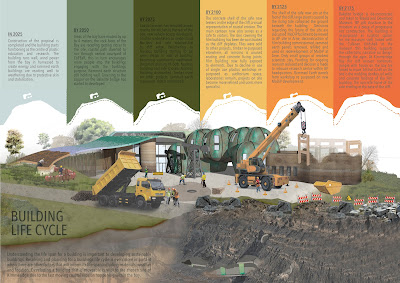On a recent trip to the Museum of
Design in Plastics, I was reminded of my first visit to LEGO headquarters in
Billund, Denmark. I have been lucky enough to work with LEGO over the past
eight years, producing games for their new LEGO sets. My first project was
updating the mobile game LEGO City for the Christmas 2017 season, and the
development team from Amuzo in Bournemouth got to visit LEGO HQ to see the toys
before they were in the shops.
As if getting to play with “secret”
LEGO was not exciting enough, our LEGO Company contact asked if we would like a
visit to the LEGO Museum, and the mythical LEGO archives, of course it was an
unanimous “Yes please!”
 |
The
LEGO Museum, formally the Christiansen family
home and carpentry workshop in
Billund, Denmark
Image credit: Nick Roberts |
The LEGO Museum in Billund is
actually the original house and workshop that Ole Kirk Christiansen, the
founder of LEGO, lived in with his family from 1916. He was a carpenter, making
tables and chairs, before a lack of orders through the Great Depression forced a
business rethink. On 10th August 1932 the workshop was dedicated to making
wooden toys.
Christiansen continued to struggle
in business, enjoying a brief period of success with yo-yos, setting his staff
to making the two yo-yo halves in bulk. When the yo-yo market also dried up and
left him with many circular wooden pieces, he needed an idea to use them up –
wheels. The carpenters set about making pull-along trucks, cars and animals.
These proved more popular. One of the first toys was a wooden pull-along duck
– and there it was, sitting in a glass case in front of me.
 |
Early wooden toys created by the Christiansen workshop before discovering plastic. |
| Image credit: Nick Roberts |
|
|
Toys were the future for the
Christiansen family, and they held a staff competition in 1934 to come up with
a new company name. The winner was “LEGO” – derived from Leg Godt, Danish
for “play well”.
It was an overseas business trip by
Ole Kirk’s son Godtfred in 1947 that would set LEGO on a pathway to global
domination of the plastic toy market. They had recently purchased one of the
first plastic moulding machines. The first plastic tests LEGO tried were small
teddy bear figures, mainly because this was the mould that came with the
machine! The definition in the plastic was a delight. Godtfred realised that
this was the future of toys – products that could be designed and mass
produced, each one identical to the last. No more carving wooden ducks for
LEGO. But the toy buying public still preferred wooden and metal toys. LEGO
needed a new product.
 |
The first tests in plastic for a fledgling LEGO company – small teddy bears
were a mould that came with their first plastic moulding machine.
Image credit: Nick Roberts |
Building sets of trucks and houses
made of plastic were already on the market, but sold as individual toys that
were incompatible with each other. Godtfred had a conversation with a buyer
that inspired him to turn the building sets into a LEGO System, made up of
building bricks that were reusable and universal. Small plastic bricks that
could be mass produced in multiple colours, then sold in sets – the beginnings
of LEGO as we know it today. Indeed, the early LEGO building sets proved very
popular, there was just one thing that was not quite right – the bricks did not
‘click’ together. A light breeze, or disgruntled little brother, could easily
send a LEGO building tumbling to the floor. There had to be a solution.
 |
An early LEGO system set, before the locking LEGO brick was invented.
Image credit: Nick Roberts |
The boffins at LEGO knew that
somehow they had to make a LEGO brick that would hold firm when attached to
another, but also be able to disconnect to allow the child to make a new model
when they chose. Many experiments took place on the best way of connecting the
bricks – dots in the plastic, criss-cross patterns, studs and holes, tiny
pinhead connectors. Eventually they settled on the classic circle and stud
pattern LEGO 8-stud brick we know today, a design that is simple but very
effective, and went on to be the foundation of every LEGO set since. As that is
the joy of LEGO, any set will connect to any other set. The minifigure people
will always slot their feet onto the LEGO studs and stand proud.
 |
The experiments the LEGO company did into lockable building bricks,
eventually patenting them all to stop the competition stealing their idea.
Image credit: Nick Roberts |
LEGO were savvy though – not only
did they patent the 8-stud brick, but they also patented all of their other
experiments, to keep the competition from copying their building brick idea.
LEGO sets would soon dominate toy shops all over the world.
So what about that LEGO archive I
teased you with? What a treat and privilege it was to visit. Underneath the
LEGO Museum is a basement hidden from public view. Large metal shelves are all
crammed together, but turning a giant handle moves the shelves along, revealing
each year of LEGO toys from 1950 to the present day. The kid in me took over
and I was soon holding the LEGO Circus Train set I had for Christmas 1988 in my
hands!
Nick Roberts, 28th April 2023












.jpg)
.jpg)
.jpg)








